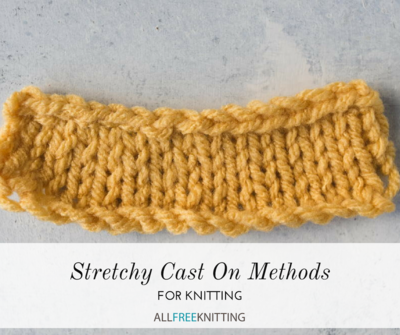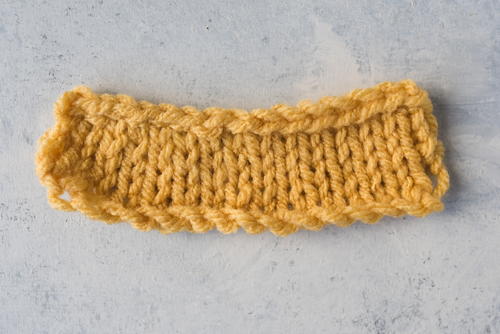6 Stretchy Cast On Methods
Learn a stretchy cast on for socks, sweaters, and more!

There comes a time in your knitting journey when you begin to find that patterns stop holding your hand through the process and basically let you choose-your-own-adventure when it comes to completing your knitted piece. Suddenly, they're just telling you to "use a stretchy cast on" for your hat, sweater, or socks—and you're left to your own defenses to figure out exactly what they mean by that. The truth is that you have a lot of options when it comes to knitting cast on methods. Stretchy ones, in particular, are abound, because wearables are popular in knitting and it's important to be able to easily take the garment on and off.
Here at AllFreeKnitting, we have an arsenal of picture and video tutorials for more cast on methods than you'll likely ever need, so we thought it would help you out to gather a few options for stretchy cast ons for reference. Nearly all of these are beginner-friendly, so whether you're knitting sweaters or leg warmers, we have for you a perfect cast on method. Stretchy cast ons all vary in use and stretchiness, so we'll explore all of your options below, in order of least stretchy to most stretchy.
For more great projects like this, subscribe to our free email newsletter!
Table of Contents
Knitting Cast On Methods: Stretchy, Stretchier, and Stretchiest!
We love this cast on method for its ease of completion, since if you know how to knit a stitch, you can easily complete this cast on method. However, with its ease comes an exchange: it's only slightly stretchy, and so it works best for more loose-fitting garments that don't require a whole lot of stretch to slip on and off.
The wrap cast on method is great for when you want to create an edge that doesn't immediately look like the cast on edge due to its subtle, space-saving design. Its stretchiness is slightly better than the knit cast on method's. However, it's difficult to keep your tension even with this super-quick cast on, so it's really recommended for short lengths, such as thumbholes or buttonholes. You'll often find this method suggested in the middle of a knitting pattern to cast on stitches where you might prematurely bind off or replacing stitches that you temporarily placed on a stitch holder.
This cast on method is near and dear to many, as it's often the first cast on method we all learn, even if it's a little bit difficult to master from the start and can generate a lot of confusion from beginners. That said, it's so popular for a reason: it's stretchy enough to really be used for any garment, but doesn't deliver so much stretch that your cast on edge will flare. If ever you find yourself unsure of which cast on method to use for a stretchy edge, the long-tail cast on should be your go-to.
Don't get this confused with the wrap cast on method! There are a couple of extra steps to this method to help give it more stretch than its simpler counterpart. This cast on method is ideal for people who prefer the versatility of the long-tail cast on, but find themselves having a hard time learning it or getting the working yarn and tail confused. It's also great for older folks with perhaps degrading motor skills, as it's much less fast-paced and involves more direct manipulation of the yarn with your hands, rather than maneuvering the needle through the yarn. It's about as stretchy as the long-tail cast on, so as a general rule, any pattern that uses that method can use this one in its place.
If you thought the long-tail cast on method was confusing, you won't enjoy the old norwegian cast on. However, if you've mastered the long-tail cast on method and you're ready for something new, just a little bit of practice is all it takes to figure this method out. It's worth it, too; the old Norwegian cast on offers more stretch than the long-tail cast on method, due to a greater amount of twisting while working it up, while still offering a very clean edge. This is the best cast on for sweater bottoms and tight ribbing out of this list, so use it if you know you're going to need a lot of extra stretch.
That's right: the creator of Jeny's Surprisingly Stretchy Bind Off has an accompanying cast-on method, and it's by far the most stretchy that we know of. It's great for anything involving ribbing or very tight-fitting garments that absolutely require a more elastic edge. This unique cast on method involves a series of slip knots, but requires very basic, smooth yarn with no extra frills, such as fur or loops.
You'll find all the patterns you'll need with the Stretchy Cast-On Archives!
Note: This project is from I Like Knitting digital magazine. Non-members can access 3 free patterns every month. Subscribe to the I Like Knitting Gold Club for unlimited access to their entire pattern archive, featuring hundreds of exclusive patterns.
What's your favorite stretchy cast on?

